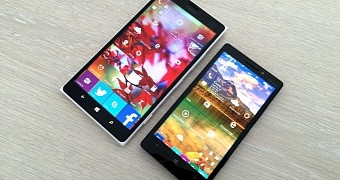Microsoft has recently confirmed the thing that everyone expected: Project Astoria is dead, so the company has no intention of bringing Android apps on Windows 10 Mobile.
Seen as a way to tackle the lack of apps on Windows phones, Android apps were supposed to arrive on Microsoft’s smartphone operating system with the help of a dedicated bridge that would allow developers to port their apps to the platform with easy-to-use and very fast solutions.
And while the implementation seemed to work great at some point during the development process of Windows 10 Mobile - some builds even had the Android bridge built-in, and insiders could install such apps through more complex solutions - Redmond no longer seems to see Project Astoria as a thing of the future.
But in reality, Android apps can still arrive on Windows 10 Mobile, but via a different method, which Microsoft considers more effective for its users. Of course, only time will tell if Microsoft’s playing the winning card with this approach.
Let’s take things one at a time and see how Microsoft reached the conclusion that Project Astoria doesn’t make sense for Windows 10 Mobile right now.
First of all, Microsoft’s statement that came as a “shock” this morning (remember that we’ve known about Project Astoria’s demise since late 2015, so the only thing Microsoft did today was to confirm the obvious) - emphasis is ours:
“We also announced the Windows Bridge for Android (project ‘Astoria’) at Build last year, and some of you have asked about its status. We received a lot of feedback that having two Bridge technologies to bring code from mobile operating systems to Windows was unnecessary, and the choice between them could be confusing. We have carefully considered this feedback and decided that we would focus our efforts on the Windows Bridge for iOS and make it the single Bridge option for bringing mobile code to all Windows 10 devices, including Xbox and PCs.”
So basically, Microsoft wasn’t the one who decided to discontinue Project Astoria, but you, the user (or the developer in the best case) were. Redmond only listened to feedback because it simply “doesn’t make sense to have to different bridges” on Windows 10 Mobile right now.
Enter Xamarin
But while Microsoft doesn’t think that Project Astoria is a must-have on Windows 10 Mobile right now, it’s still banking a lot on Xamarin, its latest acquisition and partner for the last two years or so.
Xamarin allows the creation of apps that can run on Windows 10 Mobile, Android, and iOS, making it easier for developers to tackle all these platforms at once. So offering cross-platform development software is now Microsoft’s top priority, in a new attempt to address the lack of apps on Windows 10 Mobile.
What Microsoft hopes is that developers would turn to Xamarin in order to create apps for Android and iOS, and since they’re already building an app for these platforms, why not bring it on Windows 10 Mobile as well since the development solution allows them to?
So even though Microsoft doesn’t think that Android apps aren’t needed on Windows 10 Mobile, at least not directly, it still hopes that apps that are available on Android devices will also be released for its users. In the end, the purpose is the same, only that Microsoft is aiming for a more effective manner that could also help prevent any dependency issues that could be caused when porting an app developed for Android to Windows.
Universal apps
At the same time, Microsoft’s also betting big on universal apps, and with Xamarin, Microsoft’s ready to take this new concept to a completely new level.
Until now, Microsoft’s universal apps have been developed to offer the same look and features on Windows devices, including PCs and smartphones. And that’s why Microsoft’s CEO Satya Nadella said that Android apps weren’t needed on Windows, as it wants its own universal app concept to succeed.
“This is new. We’ve had different efforts in the past but we now have one store and one app platform. Give us time to keep focused on it,” Nadella argued in late 2015.
“We are seeing, for example, for the first time on the core of Windows desktop, with 100-plus million users, active engagement, the fact that they can find these Windows applications in the store, some of the developers like Netflix are seeing more engagement for the Netflix app vs. the web. So that’s an early indicator of data that I think will entice more of these developers to build more of these applications.”
With Xamarin, universal apps can be expanded beyond Windows and could thus arrive on iOS and Android too. Of course, they won’t be apps specifically built for Windows and then ported to rival platforms, but they’ll be built with Microsoft’s solutions and come with a similar features and looks.
Certainly, this is an ambitious idea for Microsoft, but Nadella was right. Nothing can succeed overnight, so it takes time even for this plan to show the first results. But if this doesn’t work either, it’s hard to believe that the lack of apps on Windows 10 Mobile can be tackled in any other way than by bringing Android apps on the platform.

 14 DAY TRIAL //
14 DAY TRIAL //